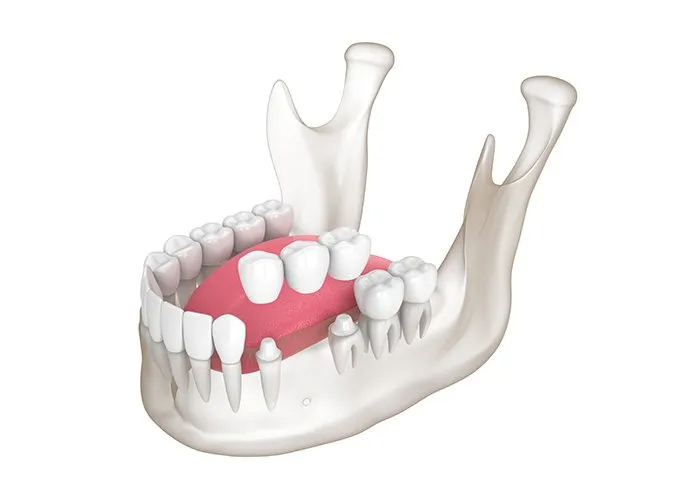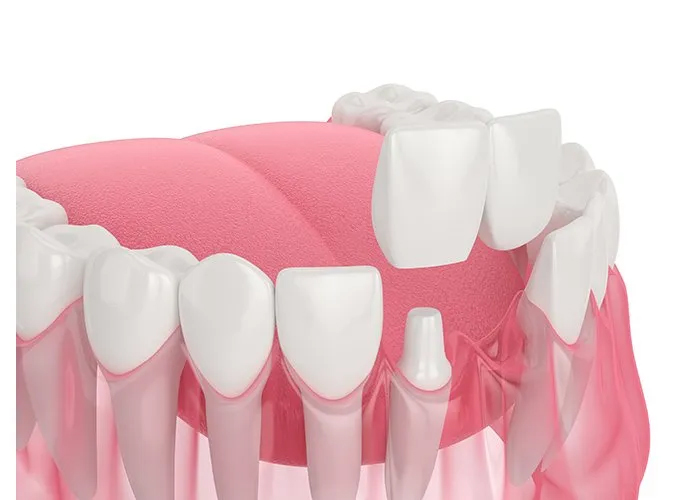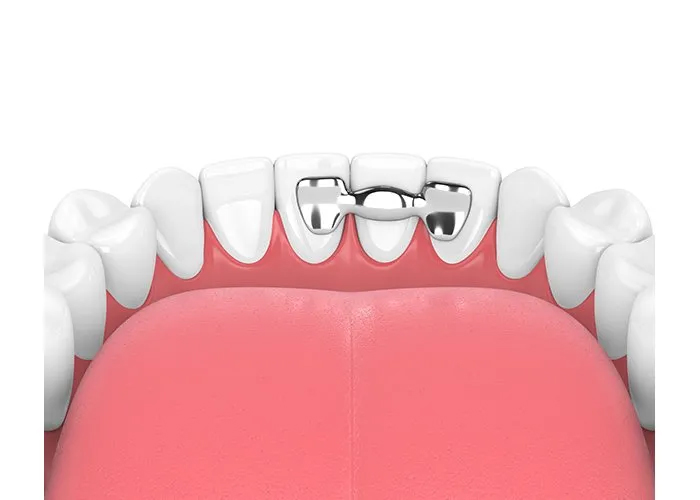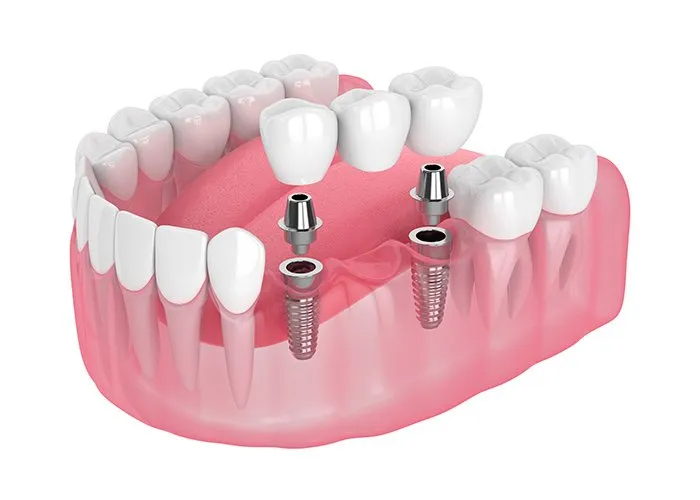When natural teeth fall out, there are options to replace them, including dental implants or a partial denture. There is a third option to replace missing teeth, and that’s with a fixed dental bridge.
Typically, we use a dental bridge when patients have fewer teeth to replace. A bridge is also called a pontic, and it’s held in place by the abutment teeth. These abutment teeth are natural teeth or implants that help support the bridge on either side of the gap.
Bridge materials can vary depending on the location and structural needs of the tooth to be replaced. This can involve conservatively preparing one or both adjacent teeth similar to that of crowning teeth. We typically use porcelain that’s colour-matched to blend in with your natural teeth.
There are four main types of bridges used in dental restorations.

A prosthetic tooth (or row of prosthetic teeth) is secured with secured with teeth either side of the space. These crowns are affixed to the anchor teeth that are adjacent to the space. The traditional bridge is the most common type and is possible to be placed if there are adjacent natural teeth on either side of the gap.

Cantilever bridges, which are comparable to their traditional counterparts, only require one tooth for support, at one end. It is important to plan this type of bridge carefully so that there is adequate support, allowing the bridge to remain safe and secure.

Instead of the standard version, this form of dental bridge employs two of the patient’s own teeth as its anchors. Connecting them is a structure made of either metal or ceramic that is attached to the abutment teeth’s rear side. The joining part is invisible to others when you smile

As an alternative to bridgework that uses crowns or a framework, implant-supported bridges make use of dental implants. If a patient has multiple teeth missing in a row, we can put an implant on every end of the bridge without needing to utilize natural teeth. The implants provide a steady anchor for the bridge.
A bridge is a false tooth, usually made of a precious metal. If it’s going to show, the dentist may attach porcelain to the base of the tooth, or another non-precious metal for strength.
Why You Should Replace Missing Teeth with a Dental Bridge
There are multiple factors that should be taken into account when it comes to replacing a missing tooth, and not just the aesthetic aspect of it. Apart from improving your smile, filling in the space can help to prevent further oral health issues.
Once you have a bridge, you need to take proper care of them. Taking care of your dental bridge properly can lead to a longer life span. Looking after your bridge affects the health of the teeth that it’s attached to. Inadequate oral hygiene can result in damage or decay, becoming a major problem if not addressed. To help ensure your bridge stays in good condition and lasts a long time, follow these home care instructions:
Not everyone is a suitable candidate for a dental bridge. The success and longevity of a dental bridge depend on several factors, including the individual’s oral health and the type of bridge required.
To have a dental bridge, an individual must have healthy adjacent teeth to act as support for the bridge. In the case of a traditional bridge, neighbouring teeth on both sides of the gap must be strong enough to handle the pressure and force of the artificial tooth in between them. If these teeth are weak or compromised, a bridge may not be a feasible option.
Similarly, an individual’s gum tissue and jawbone structure must also be healthy enough to support the bridge. In cases of bone loss or gum disease, a bridge may not be the ideal choice unless additional treatment is completed to restore oral health.
Another factor to consider is the type of bridge required. Traditional bridges require the removal of some of the healthy tooth structure in neighbouring teeth to make room for the bridge. For individuals who have strong, healthy teeth surrounding the gap, other options like implant-supported bridges may be a better alternative.
Ultimately, whether a dental bridge is suitable for an individual depends on a case-by-case evaluation by a dental professional. A treatment plan can be tailored to the individual’s unique needs and oral health status to ensure the best possible outcome.
In conclusion, not everyone is a candidate for a dental bridge. A thorough evaluation by a dental professional is necessary to determine an individual’s suitability for a bridge and the best treatment plan to restore their oral health and natural smile.
Dental bridges are a common solution for replacing missing teeth, offering a natural-looking and functional option that can help improve oral health and confidence. However, for those considering a dental bridge, a common question is how long it will last.
The lifespan of a dental bridge can vary depending on several factors. In general, a dental bridge can last anywhere from 5 to 15 years or more with proper care. However, some bridges may need to be replaced sooner due to wear and tear or other factors.
One crucial factor in the longevity of a dental bridge is proper oral hygiene. Regular brushing and flossing can help keep the artificial tooth and surrounding teeth clean and free from decay. Additionally, regular dental check-ups are essential to ensure the bridge is in good condition and to detect any potential problems early on.
The type of bridge can also impact its lifespan. Traditional bridges, which rely on neighbouring teeth for support, may weaken the healthy teeth over time and cause them to become compromised, leading to the need for a replacement. Implant-supported bridges, on the other hand, can be a more durable option, as they rely on artificial tooth roots that are inserted into the jawbone.
Other factors that can impact the lifespan of a dental bridge include the individual’s bite, the strength and health of neighbouring teeth, the material used for the bridge, and the amount of wear and tear the bridge experiences over time.
Ultimately, the best way to ensure a dental bridge lasts as long as possible is to practice proper oral hygiene and schedule regular check-ups with a dental professional. With proper care and maintenance, a dental bridge can provide many years of a healthy and beautiful smile.
A bridge can be used to replace up to five missing teeth, without the need for implants or dentures-making it an economical choice for many people. Bridges require little maintenance and provide a permanent solution for multiple missing teeth.
The number of teeth that can be replaced depends on the type of bridge you choose and its design. Traditional bridges are the most common type and usually span at least three (or up to five) locations between existing natural teeth. This allows the bridge to restore chewing function as well as improve your appearance by replacing missing front or back teeth. If you have more than five gaps in your smile, you may want to consider alternative options like dental implants or removable dentures. Your dentist will help you determine which option is best for you based on your overall dental health, budget, and personal preferences.
| Monday | 9.00 am – 6.00 pm |
| Tuesday | 9.00 am – 6.00 pm |
| Wednesday | Closed |
| Thursday | 2.00 pm – 8.00 pm |
| Friday | 9.00 am – 5.00 pm |
| Saturday | 9.00 am – 2.00 pm |
| Sunday | Closed |